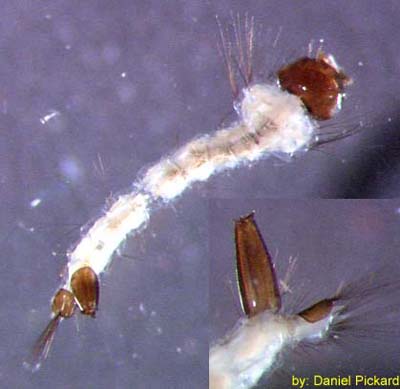
THE XERCES SOCIETY FOR INVERTEBRATE CONSERVATION Aquatic Invertebrates in Pacific Northwest Freshwater Wetlands |
| Identify taxa |
Culicidae (mosquitoes) |
Mosquitoes are found in just about every still water habitat, from lakes, ponds, marshes, swamps, and tree holes to discarded tires. They feed on microorganisms and organic detritus, which they collect using their mouth brushes. Culicid larvae have a large, distinct head capsule; their thoracic segments appear fused and swollen compared to the abdomen. They lack prolegs and have short simple antennae. Culicid larvae obtain oxygen from the air by means of a short breathing tube on top of the last abdominal segment; the pupae have a breathing tube near their head. Both stages hang near the surface of the water to breathe, and wriggle quickly into deeper water when disturbed. Female mosquitoes require a blood meal to complete egg development, and in the course of feeding many species can transmit a variety of disease organisms. The role of mosquitoes as vectors of diseases such as dengue, yellow fever, malaria, filariasis and West Nile disease have had tremedous impacts on human history and continue to do so today. In an effort to control such diseases, pesticides such as DDT have been employed, driving the bald eagle to the brink of extinction, and wreaking havoc on invertebrate populations and thus entire ecosystems. |
Size: small to medium Identifying feature(s): fused, often swollen thoracic segments; no prolegs Habitat: wetlands; ponds, pools, lakes Tolerance to pollutants: tolerant |
 |
|
© 2007 Xerces Society
Contact info@xerces.org

